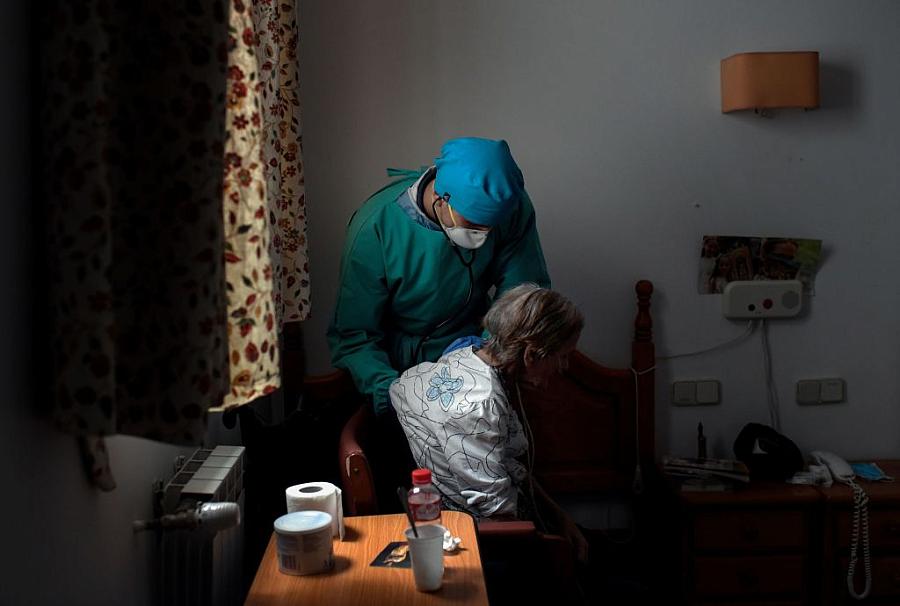How do you start reporting on COVID-19 racial disparities in nursing homes?

(Photo by Oscar Del Pozo/AFP via Getty Images)
As part of its “You Asked, We Answered” series, the Center for Health Journalism has been asking journalists what questions they have about reporting on COVID-19. This week's question: How can reporters find data on COVID-related racial disparities at nursing homes?
Alma Lara-Garcia had quite the story to tell.
Jackie Fortiér, health reporter for KPCC public radio and LAist.com, showed how the woman’s plight was part of a much broader COVID-19 crisis in nursing homes.
Lara-Garcia worked at an East Los Angeles nursing home that had a severe COVID-19 outbreak and, at least initially, little in the way of personal protective equipment, Fortiér reported. The certified nursing assistant said the facility once gave her swimming goggles to protect against the virus. It got so bad that she had suicidal thoughts because of all the stress and uncertainty.
Lara-Garcia became the face of a story about how L.A. nursing homes that serve largely Black and Latino populations have been disproportionately affected by the coronavirus. The New York Times had partnered with Fortiér’s news outlet on this report, after finding that California nursing homes with a significant percentage of Black and Latino residents were more likely to experience COVID-19 outbreaks than facilities that had mostly white residents.
Fortiér said many reporters are likely to discover that this is an issue in their own communities, since the Times analysis found these disparities to exist across the country. It then becomes a matter of pinpointing the people most impacted, she said.
“I wanted to focus on the workers, who have a really hard time doing all the things public health tells them to do, (such as) having access to PPE,” Fortiér said. “After getting sick, (Lara-Garcia) had a hard time isolating herself from her kids.
“You don’t have to talk to just doctors and nurses. There are a lot of other people who work at these facilities that we don’t traditionally talk to. You shouldn’t limit yourself to the higher echelon of health care professionals.”
Fortiér’s reporting was cited at a May L.A. County Board of Supervisors meeting at which the board approved a new inspector general position to oversee nursing homes.
“There’s also a big difference between what an administrator tells you and what residents and staff tell you about what’s going on at nursing homes,” Fortiér added.
To determine if these disparities exist in their coverage areas, however, journalists need data. Where do they find it?
The New York Times analysis looked at state and local COVID-19 case counts and compared them to nursing home characteristics at the Centers for Medicare and Medicaid Services’ Nursing Home Compare and Brown University’s long-term care dataset at LTCFocus.org.
Reporters can use these same techniques. CMS now publishes data on coronavirus cases and deaths at nursing homes around the country, and journalists can find demographic and other information at the two sites the Times used in its analysis.
We want to hear your questions about covering COVID-19 — ask your question here!
Researchers are also examining these same disparities.
Early in the pandemic, Tamara Konetzka, a professor of health services research at the University of Chicago, set out to see which factors might predict whether a given nursing home would have an outbreak.
Her team merged publicly available data on nursing home cases and deaths with data from Nursing Home Compare (for characteristics like quality ratings) and LTCFocus.org (for nursing homes' racial makeup and the percentage of residents on Medicaid).
They found that factors such as quality ratings, staffing and infection controls didn’t seem to matter.
“All nursing homes were at risk,” Konetzka said. “Which nursing homes were most likely to have cases? By far, the biggest predictor was the racial distribution of the nursing homes.” Facilities that were disproportionately impacted by COVID-19 tended to be located in coronavirus hotspots, she found.
“Nursing homes are very much a reflection of the neighborhoods where they’re located,” she said. “Nursing homes with high non-white populations are in neighborhoods with high non-white populations — and that’s where the virus is circulating. If the virus is circulating heavily in your area and your nursing home has staff go in and out of the facility and into the neighborhood every day, you're at higher risk.”
She noted that resident-level data on nursing homes doesn’t exist, so researchers can’t say, for instance, whether Black residents in a given facility are at a higher risk than white residents there.
In May, Konetzka testified before a U.S. Senate committee about her findings and suggested that if resources for nursing homes are scarce, they should first be directed toward those that serve large minority populations. Her recommendations included increased testing, staffing and personal protective equipment.
She said “there’s no reason” journalists can’t examine the same data sources she did to probe whether these types of disparities are prevalent in their communities.
Jen Mishory and her colleagues at The Century Foundation, a liberal think tank based in New York City, have also been researching COVID-related racial disparities at nursing homes.
“I think it’s great that journalists are looking to answer this question,” said Mishory, a senior fellow at The Century Foundation.
She said The New York Times’ analysis shows the path for how other reporters can learn about these disparities, and also recommended reviewing the University of Chicago research, as well as LTCfocus.org for racial data on nursing homes.
“As we’re trying to identify strategies to address COVID infections and mortality overall, and address some of these disparities, you almost certainly have to look at nursing homes, because they have such high rates,” she said. “That has to be part of the solution set.”
**
